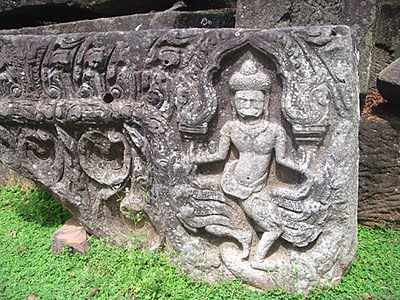 This partial lintel at Prasat Phimai sits in a quiet corner of the complex. It shows Krishna suduing the serpent Kaliya.
This partial lintel at Prasat Phimai sits in a quiet corner of the complex. It shows Krishna suduing the serpent Kaliya.
In a quiet northwest corner of the first enclosure at
Prasat Phimai is a mini-storage dump of architectural items that the Thai authorities didn't find a home for when they reconstructed the temple in the 1960s. In fact I came across this open-air storage section, as well as a depository for a bunch of lintels and the forgotten corner full of sandstone dvarapula antefixes, which I showed you in an earlier post. The mix-n-match dump contained a variety of objects, whilst the lintel collection - containing at least a dozen lintels, some in good condition, others very badly worn, which the conservation team found on site but couldn't find their original locations and so kept them all together - are now housed on a raised platform to the west of the central sanctuary. Worth a look, if like me, you love your lintels.
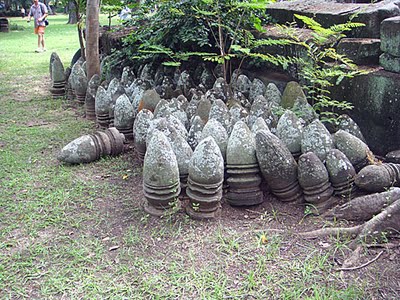 This is not a collection of cluster bombs, but architectural decorations that can be found on top of enclosure walls
This is not a collection of cluster bombs, but architectural decorations that can be found on top of enclosure walls
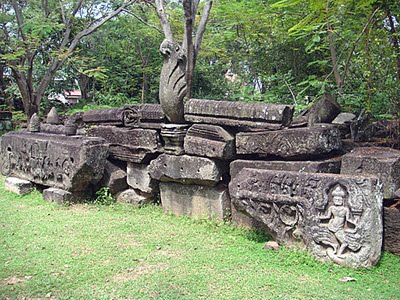 A mini dump of architectural items such as lintels, nagas and pilasters in a quiet corner
A mini dump of architectural items such as lintels, nagas and pilasters in a quiet corner
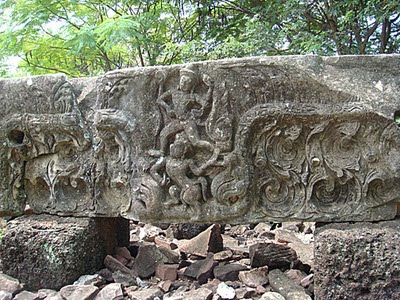 A worn lintel of Krishna riding on Garuda
A worn lintel of Krishna riding on Garuda
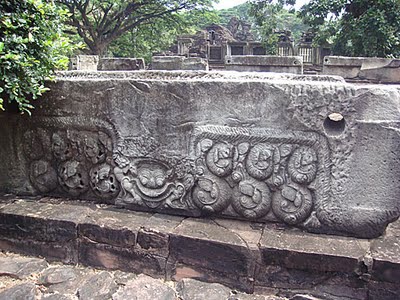 This unfinished lintel is of a kala and double rows of floral vegetation
This unfinished lintel is of a kala and double rows of floral vegetation
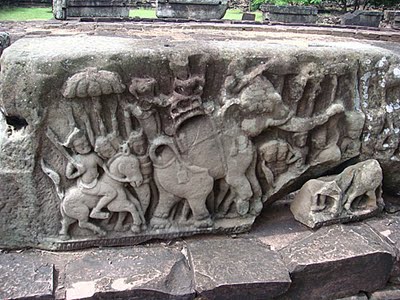 A massive elephant, a horse and various figures provide the detail on this partial lintel which may've originally shown Krishna fighting the elephant
A massive elephant, a horse and various figures provide the detail on this partial lintel which may've originally shown Krishna fighting the elephant
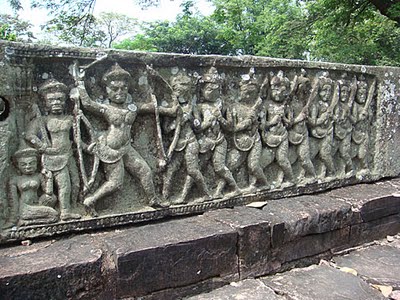 This vivid lintel shows Rama armed with a bow and arrow, taking on eight demons
This vivid lintel shows Rama armed with a bow and arrow, taking on eight demons
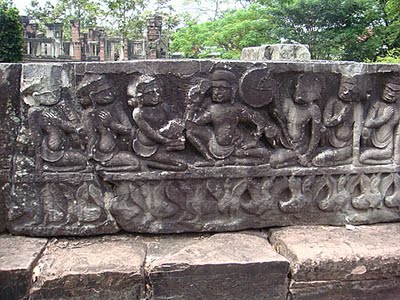 Above a row of hamsas appear a group of important courtiers with a royal personage in the center
Above a row of hamsas appear a group of important courtiers with a royal personage in the center
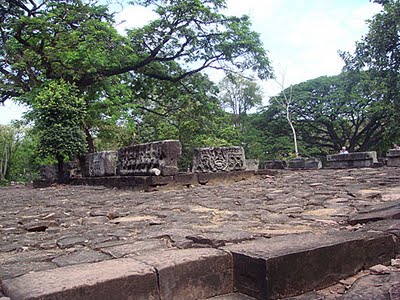 This raised platform to the west hosts about a dozen lintels of varying descriptions and conditions
This raised platform to the west hosts about a dozen lintels of varying descriptions and conditionsLabels: Isaan, Prasat Phimai
 This partial lintel at Prasat Phimai sits in a quiet corner of the complex. It shows Krishna suduing the serpent Kaliya.
This partial lintel at Prasat Phimai sits in a quiet corner of the complex. It shows Krishna suduing the serpent Kaliya. This is not a collection of cluster bombs, but architectural decorations that can be found on top of enclosure walls
This is not a collection of cluster bombs, but architectural decorations that can be found on top of enclosure walls A massive elephant, a horse and various figures provide the detail on this partial lintel which may've originally shown Krishna fighting the elephant
A massive elephant, a horse and various figures provide the detail on this partial lintel which may've originally shown Krishna fighting the elephant







1 Comments:
Cool! I work as an archaeologist in the Maya area and we have a similar situation. At the site of Copan early explorers would just pick up interesting bits of sculpture and by the time actual archaeologists came around these pieces were scattered all over. So the archaeologists just collected them together in piles that later archaeologists nicknamed GOK piles. GOK for God Only Knows, as god only knows where these all came from. Luckily, the different buildings at Copan each had a different iconographic theme, and many elements were repeated. Therefore, once the archaeologists excavated some of the buildings they could go back into the GOK piles and pick out the pieces missing from that building. The process has been very successful and they've managed to reduce most of the GOK piles. Hopefully the archaeologists here will be able to do the same!
Post a Comment
<< Home